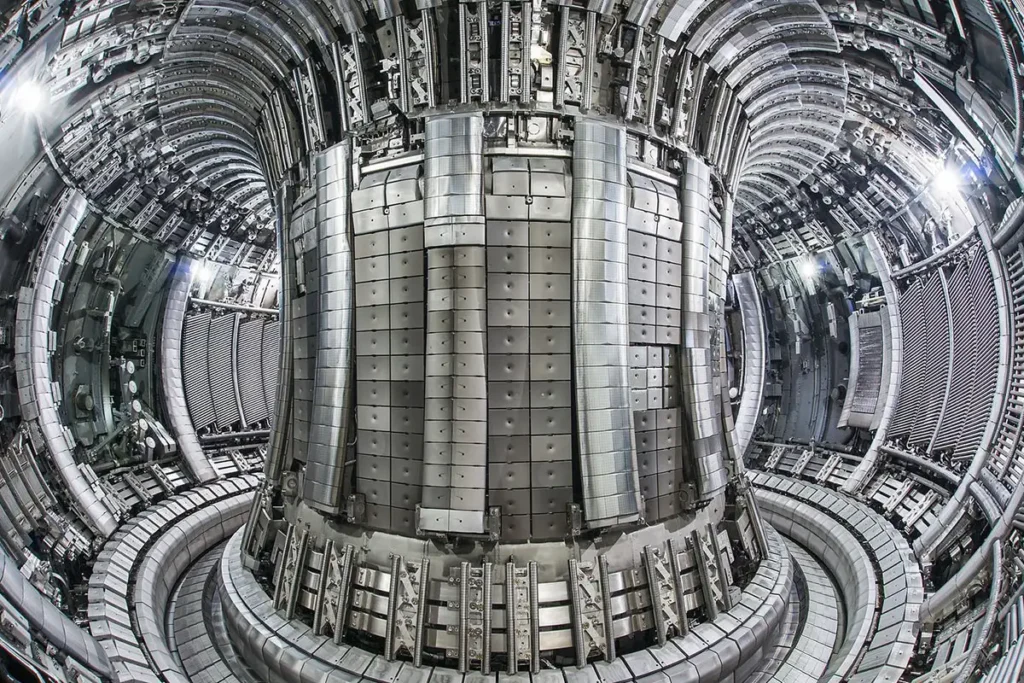Image generated by Bing Image Creator by Designer.
The future is fusion?
There are two main ways of producing nuclear energy: fission and fusion.[1] Both kinds of nuclear reaction were discovered in the 1930s. The original nuclear weapons and power plants worked by nuclear fission. However, nuclear fission remains far better understood than its elusive sibling, nuclear fusion.
Electricity has been a crucial part of human existence since the nineteenth century. Our daily lives, as well as the global economy, depend on it. Where we source our electricity is a particularly pertinent question given the challenges posed by climate change. Nuclear energy has been touted as an alternative to coal and gas for some time, though it has not always been a very popular one. Nuclear fusion promises to be one of defining scientific advancements of the twenty-first century.
What nuclear fusion is, and how it can shape the UK’s future, are the subject of this article. We believe argues that nuclear fusion represents the most promising energy source for the future, with the UK positioned to be a global leader in this groundbreaking technology
What is Nuclear Fusion?
Atoms consist of positive particles, neutral particles, and negative particles called protons, neutrons, and electrons respectively. Electrons orbit around the nucleus of an atom, which consists of protons and neutrons stuck together. The number of protons and neutrons in an atom’s nucleus determines what element it is.
Nuclear fission is achieved by separating sub-atomic particles by firing neutrons at the nucleus of an atom. While technically this is possible with any element, fission only produces enough energy to be practically useful when using heavy and relatively reactive elements, such as uranium and plutonium. When using an element like uranium, it is possible to start a chain reaction of separations within the nucleus that releases vast amounts of energy.

Inside the JET fusion reactor (via newscientist.com)
On the other hand, fusion works by heating atoms and fusing their nuclei together. Light elements like hydrogen are best suited to nuclear fusion. Through fusion, two light atoms are heated and combined together into one atom, thus converting two atoms of one element into one atom of another. This produces even greater quantities of energy than nuclear fission. The Sun generates energy through nuclear fusion. It is a far more efficient way of producing energy, but it is very difficult to do.
Although nuclear fission has been understood and used to generate electricity for well over half a century, fusion power remains elusive. The problem with fusion is not starting the reaction, it is sustaining it. As long as we are unable to sustain a fusion reaction for any length of time, we will be unable to fully harness its power-generating potential.
The Latest Developments
Nuclear fusion is an exciting opportunity for humanity. It is believed that nuclear fusion can provide ‘basically unlimited’ power, using elements that are abundant on earth. Scientists across the globe are working to sustain a fusion reaction, with researchers in the United States achieving a net energy gain in a fusion reaction for the second time in the space of a year last July.
[…] a key point to takeaway is that Britain is in amongst the front of the pack chasing sustainable nuclear fusion.
What is exciting from a British perspective is our role, and our potential future role, in the progression towards unlocking nuclear fusion. In early 2022, headlines were breaking that a similarly groundbreaking discovery had been made in the UK, with enough energy produced from a fusion reaction to ‘boil about 60 kettles’ worth of water’. While this may not seem like a lot, this was a significant development at that time. Although fusion development has moved on since 2022, a key point to takeaway is that Britain is in amongst the front of the pack chasing sustainable nuclear fusion.
Britain’s Nuclear Fusion Future
Sam Howell has discussed the importance of so-called ‘STEM talent’ in the development of technology, emphasising the importance of ‘non-degree holding technicians and machinists’ as well as those with PhDs and other academic qualifications.[2]
The political and economic benefits of nuclear fusion being harnessed by humanity for the first time in the United Kingdom are unquantifiable. One of the sectors in which the UK excels is higher education and research. According to QS World Rankings, Oxford, Cambridge, and Imperial College London are amongst the top ten universities in the world for natural sciences, which includes physics. There are many other leading UK universities not far behind. It is not controversial to say that the UK provides excellent training and research opportunities for those in STEM fields.
Ensuring Britain keeps its place as a leading innovator in fusion research must be one of our nation’s top priorities.
Howell’s point that a ‘robust STEM workforce is necessary to invent and develop new technologies’ must be heeded in the coming decades.[3] Incentivising STEM professionals to either stay or immigrate to the UK can help this country maximize the utility of its research institutions. The £822 application fee for a ‘Graduate visa’ could perhaps be lowered or waived entirely, at least for graduates from fields that could benefit the national interest.
The same can be said for visa schemes incentivising immigration for those who have not been educated in the UK, such as the Global Talent Scheme and Skilled Workers visas. Expanding the number of British citizens who take STEM subjects at school or university would expand the talent pool, but this is a complex policy and something that should be voluntary, rather than enforced. It is a subject for another time. Suffice it to say, there is plenty of opportunity for the ‘STEM talent’ pool to grow in the UK.
Conclusion: Looking to the Future
The recent closure of JET, the UK’s long running and highly successful fusion experiment facility, marks the completion of a bountiful era of nuclear fusion research in Britain. Since the closure, the government has pledged to invest over half a billion pounds into fusion research. Although it would be preferable to aim for the construction of a nuclear fusion powerplant earlier than the current date of 2040, the establishment of a new £220 facility called STEP, is cause for excitement.
Given the potentially immense upside to investment in nuclear fusion, research into this technology should be at the top of this country’s agenda. Headline winning developments, such as the new STEP facility, ought to be supplemented with other policies, such as the incentives to bring STEM professionals and graduates to the UK and increase the number of home students enrolled on STEM courses.
In light of the recent batch of pledges made by America and China to renew the quest for nuclear fusion, it is reassuring and exciting that Britain is amongst the leading nations in this endeavour. Ensuring Britain keeps its place as a leading innovator in fusion research must be one of our top priorities.
[1] The following is a summary of Reinders, The Fairy Tale of Nuclear Fusion, pp.8-14.
[2] Howell, ‘Technology Competition’, p.2.
[3] Howell, ‘Technology Competition’, p.15.
Sources
- Amos, Jonathon, ‘Major breakthrough on nuclear fusion energy’, BBC News, (9 February 2022) <https://www.bbc.co.uk/news/science-environment-60312633> [accessed: 14/01/2024].
- ‘Graduate visa’, GOV.UK, <https://www.gov.uk/graduate-visa> [accessed: 14/01/2024].
- Home Office and UK Visas and Immigration, ‘New immigration system: what you need to know’, GOV.UK, (28 January; 11 August 2023) <https://www.gov.uk/guidance/new-immigration-system-what-you-need-to-know> [accessed: 14/01/2024].
- Howell, Sam, ‘Technology Competition: A Battle for Brains’, Center for a New American Security, (24 July 2023).
- ‘Is nuclear fusion a clean-energy planet saviour?’, Al Jazeera, (13 December 2022) < https://www.aljazeera.com/news/2022/12/13/is-nuclear-fusion-a-clean-energy-planet-savior> [accessed: 14/01/2024].
- Peng, Dannie, ‘China’s new Fusion Energy Inc to pool national resources in push to build ‘artificial sun’’, South China Morning Post, (3 January 2024) < https://www.scmp.com/news/china/science/article/3247145/chinas-new-fusion-energy-inc-pool-national-resources-push-build-artificial-sun> [accessed:14/01/2024].
- ‘QS World University Rankings By Subject 2023: Natural Sciences’, QS Top Universities, (publication date unknown) <https://www.topuniversities.com/university-subject-rankings/natural-sciences> [accessed: 14/01/2024].
- Reinders, L.J., The Fairy Tale of Nuclear Fusion, (Cham, Switz.; Springer: 2021).
- Stallard, Esme,
- ‘Nuclear fusion breakthrough – what is it and how does it work?’, BBC News (14 December 2022) <https://www.bbc.co.uk/news/science-environment-63957085> [accessed: 14/01/2024].
- ‘UK’s nuclear fusion site ends experiment after 40 years’, BBC News, (14 October 2023) <https://www.bbc.co.uk/news/science-environment-67101176> [accessed: 14/01/2024].
- UK Atomic Energy Authority; Department for Business, Energy & Industrial Strategy and Andrea Leadsom, ‘UK to take a big ‘STEP’ to fusion electricity’, GOV.UK, (3 October 2019) <https://www.gov.uk/government/news/uk-to-take-a-big-step-to-fusion-electricity> [accessed: 14/01/2024].
- ‘US scientists achieve net energy gain in fusion reaction for second time’, Al Jazeera, (7 August 2023) <https://www.aljazeera.com/news/2023/8/7/us-scientists-achieve-net-energy-gain-in-fusion-reaction-for-second-time> [accessed: 14/01/2024].




2 thoughts on “The Exciting Future of Nuclear Fusion Research”